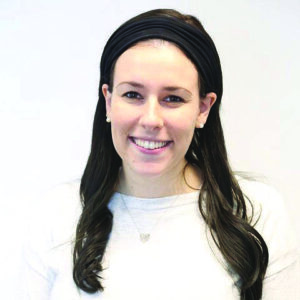
Rebecca Mayer
“Getting in has gotten easier, fitting in has not.”
These were the words on a poster I first saw more than a dozen years ago. Accompanying these words was a picture of a young boy going into the school building via a ramp, alone. A few feet over sat a group of boys on the stairs, socializing in a tight circle.
Years later, I still think about this poster often and how true it can still be today. We have come so far as a community, taking many steps to make spaces more physically accessible, but are we putting in the same efforts toward truly increasing sensitivity? Do we actively look for ways to include everyone around us?
This month is Jewish Disability Awareness, Acceptance and Inclusion Month, which serves as an annual reminder to step back, celebrate how far we as a community have come and notice where we can continue to push ourselves to make our spaces more inclusive.
According to U.S. Census Bureau data from 2021, about 13% of the U.S. population has a disability. According to the Centers for Disease Control and Prevention, nearly one in 10 U.S. children has a developmental disability. Considering that for many, attending synagogue on Shabbat and holidays is a pillar of Jewish communal involvement, and currently, some people with disabilities and their families may not feel comfortable going, the question arises: How do we create an environment where our synagogues are a space where all Jewish people belong, and not only those who can get in, sit, focus and follow along with the services?
The following are achievable, low-cost to no-cost adjustments that create a real impact in terms of making all congregants feel more comfortable in synagogue.
Create an inclusion committee: Assemble a diverse group of congregants that will identify and address any concerns about accessibility, and then brainstorm and implement solutions to ensure that all congregants feel welcome, appreciated and included in all parts of synagogue programming and services. This creates a space for individuals with disabilities to voice ideas and meaningfully contribute to conversations.
Allow for familiarity with the space: Offer tours of the synagogue to people who are new or visiting so they can become familiar and feel more comfortable in the space. They can see and touch tallitot, stand at the bimah and find a seat where they will be comfortable sitting. Additionally, point out “quiet spaces” and let people know that they can use them if they are feeling overwhelmed. Familiarity can help ease some anxiety surrounding new situations.
Put up clear signage: Make sure that congregants are aware of the accessible accommodations and resources available to them in your synagogue. For example, post clear, picture-based signage around your synagogue, and Braille signs, where possible, that indicate the locations of and path towards the accessible accommodations throughout the building. This may include entrances and exits, accessible bathrooms, accessible seating in the sanctuary and places to park mobility devices if they are not needed full time. Be sure to add all applicable symbols of accessibility, such as the icons for wheelchair access and assistive listening devices, to the marketing materials for your synagogue and its events, so families can know what to expect.
Invite focus and context: During services, announce page numbers often and display them from a prominent and central location. Motion times to sit versus stand. Describe the prayer books by publisher, color and size. Try to give context to the part of the service you’re up to. Acquire some large-print and transliterated prayer books, as they could be easier for some to follow along with. Get creative in how you connect congregants to the service and seek opportunities to refocus regularly to help congregants stay on task.
Seek out participation: Ask people with disabilities in advance to participate in services. In consultation with the rabbi, find times to call congregants with disabilities to the Torah, or ask them to give d’vrei Torah, light the synagogue’s menorah or make kiddush for the congregation. Visibility goes a long way to project the message that all Jewish people belong in your synagogue’s space. Other creative ideas to help people get involved are offering to arrange a buddy system to pair someone with another congregant who can offer guidance, or to arrange a family-style service where prayers may be slower and recited together. These programs can be great for inviting families who don’t typically feel comfortable joining quieter and faster services. An invitation to participate may be the push someone needs to feel welcome and become a member.
Kol Yisrael Arevim Zeh Bazeh — “All Jews are responsible for one another.” This principle of Judaism can be found in the Talmud (Shavuot 39a). It is our obligation to make sure that each person in our community has their needs met. Synagogues act as a focal point for the Jewish community. Of course, our community is quite diverse, and connection to a synagogue can mean many different things to different people, but primarily, it is a place for Jewish people to come together and act as one congregation, one community.
Rebecca Mayer is the director of Yachad New York and of Yachad’s new talent development.






